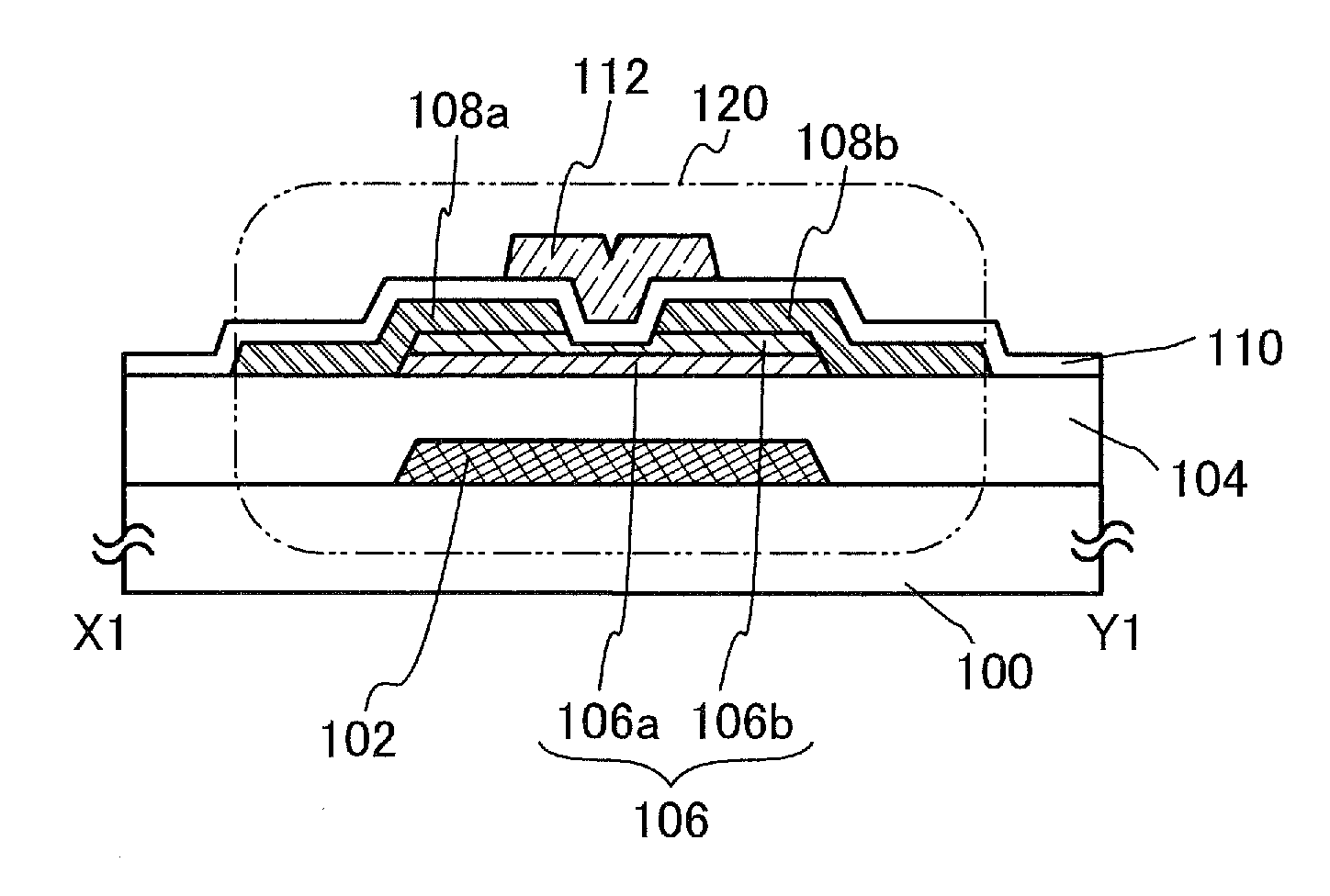Semiconductor device
a technology of semiconductor devices and semiconductor devices, applied in the direction of semiconductor devices, electrical equipment, transistors, etc., can solve the problems of difficult control of circuits including such transistors, and the negative threshold voltage of transistors that are not suitable for use in semiconductor devices in integrated circuits
- Summary
- Abstract
- Description
- Claims
- Application Information
AI Technical Summary
Benefits of technology
Problems solved by technology
Method used
Image
Examples
embodiment 1
[Embodiment 1 ]
[0065]In this embodiment, one embodiment of a semiconductor device and one embodiment of a method for manufacturing the semiconductor device are described with reference to FIGS. 1A and 1B and FIGS. 2A to 2F. In this embodiment, a transistor including an oxide semiconductor stacked layers is described as an example of the semiconductor device.
[0066]FIGS. 1A and 1B illustrate an example of a structure of a transistor 120. FIG. 1A is a plan view of the transistor 120, and FIG. 1B is a cross-sectional view taken along a chain line X1-Y1 in FIG. 1A.
[0067]As illustrated in the cross-sectional view in the channel length direction in FIG. 1B, the transistor 120 includes, over a substrate 100 having an insulating surface, a gate electrode layer 102, an insulating layer 104, an oxide semiconductor stacked layers 106 including an oxide semiconductor layer 106a and an oxide semiconductor layer 106b, a source electrode layer 108a, a drain electrode layer 108b, an insulating layer...
embodiment
[2]
[0152]In this embodiment, as an example of a semiconductor device which includes the transistor described in Embodiment 1, a semiconductor device which can hold stored data even when not powered and which has an unlimited number of write cycles will be described with reference to drawings.
[0153]FIGS. 3A and 3B illustrate one example of a structure of the semiconductor device. FIG. 3A is a cross-sectional view of the semiconductor device, and FIG. 3B is a circuit diagram of the semiconductor device.
[0154]The semiconductor device illustrated in FIG. 3A includes a transistor 160 including a first semiconductor material in a lower portion, and a transistor 162 including a second semiconductor material in an upper portion. As the transistor 162, the transistor of one embodiment of the present invention described in Embodiment 1 can be employed.
[0155]Here, the first semiconductor material and the second semiconductor material are preferably materials having different band gaps. For exa...
embodiment 3
[Embodiment 3]
[0186]In this embodiment, a semiconductor device including the transistor described in Embodiment 1, which can hold stored data even when not powered, which does not have a limitation on the number of write cycles, and which has a structure different from the structure described in Embodiment 2 will be described with reference to FIGS. 4A and 4B.
[0187]FIG. 4A illustrates an example of a circuit configuration of the semiconductor device, and FIG. 4B is a conceptual diagram illustrating an example of the semiconductor device. First, the semiconductor device illustrated in FIG. 4A will be described, and then, the semiconductor device illustrated in FIG. 4B will be described.
[0188]In the semiconductor device illustrated in FIG. 4A, a bit line BL is electrically connected to the source electrode layer or the drain electrode layer of the transistor 162, a word line WL is electrically connected to the gate electrode layer of the transistor 162, and the source electrode layer ...
PUM
 Login to View More
Login to View More Abstract
Description
Claims
Application Information
 Login to View More
Login to View More - R&D
- Intellectual Property
- Life Sciences
- Materials
- Tech Scout
- Unparalleled Data Quality
- Higher Quality Content
- 60% Fewer Hallucinations
Browse by: Latest US Patents, China's latest patents, Technical Efficacy Thesaurus, Application Domain, Technology Topic, Popular Technical Reports.
© 2025 PatSnap. All rights reserved.Legal|Privacy policy|Modern Slavery Act Transparency Statement|Sitemap|About US| Contact US: help@patsnap.com



